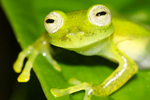Since its announcement on Thursday, the olinguito—the world’s newest mammal—has taken the world by storm. Hundreds of articles have been written about the new species, while its cuddly appearance has already been made the subject of cartoons. Now, conservationists have released the first photos of a baby olinguito. The new photos come from La Mesenia Conservation Project in Colombia, an Andean cloud forest reserve that is a project area for the NGO SavingSpecies.
Biologists and local people have known about the olinguito for decades, however the small mammal, which has been compared to a cross between a teddy bear and a cat, was confused with its lowland rainforest relatives, the olingos. The mistaken identity ran so deep, that zoos in the past tried to breed the newly-described species with olingos—unsuccessfully, of course. Now, new research appearing in ZooKeys has revealed why: the olinguito is not only a distinct species, but has been separated from its relatives by 3-4 million years. In fact, he olinguito is the smallest of the olingos with a distinct body shape and brighter-colored fur; in addition, it is the only olingo found in high cloud forests. These differences were first noted by lead author Kristofer Helgen, Director of Mammals at the Smithsonian Smithsonian Institution, when he was looking through olingo specimens in museums.
When the news came out announcing the olinguito to the world, conservationists working in the Colombia Andes wondered if their resident olingos were in fact the newly-described species, olinguitos. They e-mailed photos to Roland Kays with the North Carolina Museum of Natural Sciences who helped discover the new species along with Helgen. Kays confirmed that the photos indeed showed olinguitos, including a baby olinguito that was photographed in a nest built in a dead bromeliad.

A baby olinguito in La Mesenia Reserve in Colombia. Photo by: Luis Mazariegos.
“All of us are simply delighted to know that we have been helping to protect an animal that was unknown to science less than 48 hours ago—and have been helping to restore its habitat for years!” said Stuart Pimm the head of SavingSpeices and an ecologist at Duke University. “Clearly this is one of the most magnificently biodiverse areas of the world—and who knows what scientists will find next—if the habitat is connected, protected and restored.”
SavingSpecies has been purchasing and reforesting land in degraded areas of the Colombian Andes, in a bid to reconnect forest fragments. The project area is also home to eleven endangered bird species and numerous orchids, including a species in the Dracula genus (see video below). Serendipitously, the project area is also home to olinguitos. Although classified as carnivores (they are in the raccoon family), olinguitos primarily consume fruit. They are largely nocturnal and give birth to one youngster at a time.
The Andean cloud forests are one of the most biodiverse regions in the world, with wide ranges in topography and forest types these ecosystems are also home to a huge number of endemic species (i.e. species found no-where else in the world). However, conservation in the Andean forests has often lagged behind efforts in the Amazon and Central American forests.
“This is exactly the kind of species that our projects help protect—scarce, wide ranging predators are hit hardest when forests become fragmented. By reconnecting a large piece of forest that was almost pinched off, we knew we could make a huge difference,” notes Pimm.
Olinguitos are found only in Ecuador and Colombia. Its discoverers estimated that around 42 percent of the species’ original range had already been lost, although they don’t believe the species is not at high risk of extinction—yet.
For much more on the discovery of the olinguito: Scientists discover teddy bear-like mammal hiding out in Andean cloud forests (photos)

The mother olinguito. Photo by: Luis Mazariegos.
Related articles
Scientists discover teddy bear-like mammal hiding out in Andean cloud forests (photos)

(08/15/2013) While the olinguito looks like a wild, tree-climbing teddy bear with a cat’s tail, it’s actually the world’s newest mammalian carnivore. The remarkable discovery—the first mammal carnivore uncovered in the Western Hemisphere since the 1970s—was found in the lush cloud forests of the Andes, a biodiverse region home to a wide-range of species found no-where else. Dubbed the olinguito (Bassaricyon neblina), the new mammal is a member of a little-known, elusive group of mammals—olingos—that are related to raccoons, coatis, and kinkajous. However, according to its description in the journal Zookeys, the olinguito is the most distinct member of its group, separated from other olingos by 3-4 million years (or longer than Homo sapiens have walked the Earth).
Peruvian night monkey threatened by vanishing forests, lost corridors

(03/18/2013) The Peruvian night monkey (Aotus miconax) is one of the world’s least known primates, having never been studied in the wild–until now. Found only in the cloud forests of northern Peru, a group of scientists with Neotropical Primate Conservation and the National University of Mayor San Marcos have spent 12 months following a single group of this enigmatic monkey species in a small forest patch. The results of their research, published in mongabay.com’s open access journal Tropical Conservation Science, shows that protecting forests, even small forest fragments, is vital to the species’ survival.
Photos: new mammal menagerie uncovered in remote Peruvian cloud forest

(10/03/2012) Every year scientists describe around 18,000 new species, but mammals make up less than half a percent of those. Yet mammal surprises remain: deep in the remote Peruvian Andes, scientists have made an incredible discovery: a rich cloud forest and alpine grassland ecosystem that may be home to no less than eight new mammal species. Although most of these new mammals are currently under study—and have not been officially described yet (a process which can take several years)—lead scientists, Horacio Zeballos of Peru and Gerardo Ceballos of Mexico are certain they have uncovered a small forest, surrounded by deforestation and farmland, that shelters a remarkable menagerie of mammals unknown to scientists until now.
Pictures: Bolivian park may have the world’s highest biodiversity

(09/12/2012) With over 90 species of bat, 50 species of snake, 300 fish, 12,000 plants, and 11 percent of the world’s bird species, Madidi National Park in Bolivia may be the world’s most biodiverse place, according to new surveys by the the Bolivian Park Service (SERNAP) with aid from the Wildlife Conservation Society (WCS).
Private reserve safeguards newly discovered frogs in Ecuadorian cloud forest

(08/28/2012) Although it covers only 430 hectares (1,063 acres) of the little-known Chocó forest in Ecuador, the private reserve las Gralarias in Ecuador is home to an incredible explosion of life. Long known as a birder’s paradise, the Reserva las Gralarias is now making a name for itself as a hotspot for new and endangered amphibians, as well as hundreds of stunning species of butterfly and moth. This is because the reserve is set in the perfect place for evolution to run wild: cloud forest spanning vast elevational shifts. “The pacific slope cloud forests […] are among the most endangered habitats in the world,” explains Reserva las Gralarias’ founder, Jane Lyons, in a recent interview with mongabay.com.
Beautiful new bird discovered in Peruvian cloud forest
(08/07/2012) Four years ago in a remote cloud forest in Peru’s Cerros del Sira mountain range, three recently graduated students from Cornell University discovered a never-before-recorded species of black, white, and scarlet bird. Now described in the scientific journal, The Auk, the bird has been dubbed the Sira barbet (Capito fitzpatricki).
New colorful rainforest frog named after Prince Charles (PICTURES)
(07/04/2012) Researchers have discovered a previously unknown species of frog and named it in honor of Price Charles, according to a paper published in the journal Zootaxa.
Cloud forests may be particularly vulnerable to climate change
(03/26/2012) Mexico could lose nearly 70 percent of its cloud forests due to climate change by 2080, according to new research published in Nature Climate Change, that has implications for cloud forests worldwide.
3 new private conservation reserves established by communities in Peru
(03/21/2012) Three new private conservation areas in the Amazon-Andes region of Peru will help buffer the country’s national park system while offering new opportunities for local people to benefit from protecting ecosystems.
Majority of Andes’ biodiversity hotspots remain unprotected

(02/01/2012) Around 80 percent of the Andes’ most biodiverse and important ecosystems are unprotected according to a new paper published in the open-access journal BMC Ecology. Looking at a broad range of ecosystems across the Andes in Peru and Bolivia, the study found that 226 endemic species, those found no-where else, were afforded no protection whatsoever. Yet time is running out, as Andean ecosystems are undergoing incredible strain: a combination of climate change and habitat destruction may be pushing many species into ever-shrinking pockets of habitat until they literally have no-where to go.